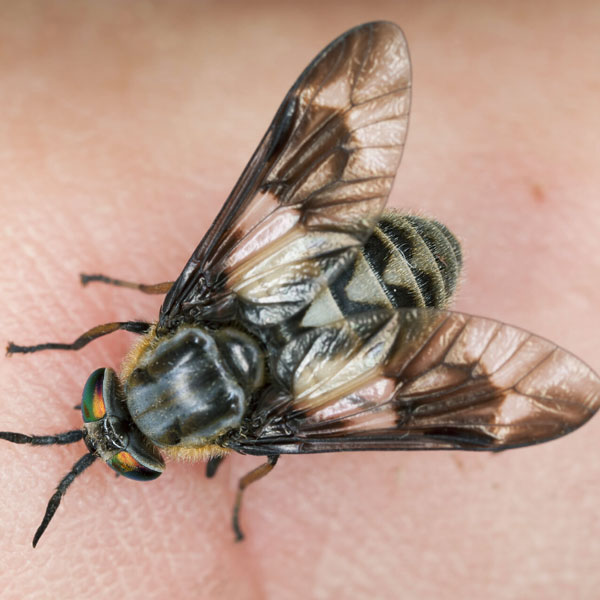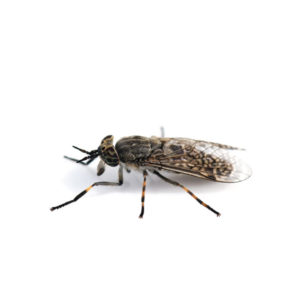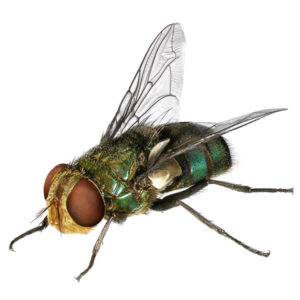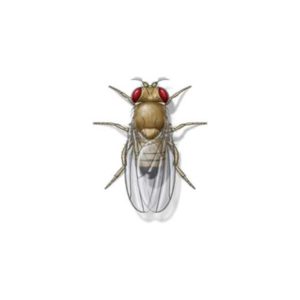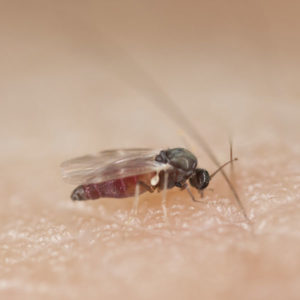Deer flies and horse flies are large, heavy-bodied insects that are persistent pests of wildlife, livestock, and humans. Their blood-sucking habits also raise concerns about the possible transmission of disease agents. They are notorious pests of horses, mules, cattle, hogs, dogs, and other mammals, including humans. Deer flies, which commonly bite humans, are smaller with dark bands across the wings and colored eyes similar to those of horse flies. An attack by a few of these persistent flies can make outdoor work and recreation miserable.
Deer Fly Identification
What Do Deer Flies Look Like?
Deer flies are characterized by their distinctive appearance. Adults typically measure between 1/4 to 1/3 inches in length. They possess large, brightly colored eyes—often gold or green—which can appear iridescent. Their bodies are robust, with a dark or sometimes yellowish-brown coloration, and their wings often display dark bands or patterns.
A key distinguishing feature of deer flies compared to other flies is their wing pattern and the antenna structure, which is more elongated and segmented.
Signs of a Deer Fly Infestation
Identifying a deer fly infestation goes beyond noticing a solitary fly. Signs include:
- Frequent sightings of multiple deer flies, especially in outdoor areas.
- Observing deer flies aggressively pursuing humans and animals.
- Finding larvae in moist soil or aquatic environments close to your residence.
Habitat, Diet, Life Cycle & Bites
Where Do Deer Flies Live?
Deer flies and horse flies can be found near aquatic habitats that support larval development. Most deer flies and horse flies are found in brushy or low-lying pasture areas near creeks, streams, or tanks that provide damp soils in which the immature stages develop. They prefer areas that offer abundant vegetation and a suitable breeding ground for laying eggs. While they don’t typically enter buildings, deer flies can accidentally wander indoors from time to time. Houses or hotels with swimming pools could have more issues with the pest because shiny surfaces and quick movements attract deer flies to people. The proximity of these habitats to human activity can lead to increased encounters.
Diet of a Deer Fly
The adult female deer fly feeds on blood, which is necessary for egg development. This diet drives their aggressive behavior towards humans and animals. Males, conversely, primarily feed on nectar and do not bite.
Life Cycle of a Deer Fly
The deer fly life cycle includes four stages: egg, larva, pupa, and adult. Females lay eggs on vegetation overhanging water or directly into moist soil. Once hatched, the larvae develop in aquatic or semi-aquatic environments, feeding on organic matter and small invertebrates. The transition from larvae to adults can take a year, with adults emerging in late spring to early summer.
Deer Fly Bites
Female deer flies and horse flies can and will bite people, and the painful bites may occur on any part of the body. Deer fly bites can be painful due to their cutting and lapping method of feeding.The bite often results in visible bleeding wounds and general first aid-type skin creams may help to relieve the pain from bites. In rare instances, there may be allergic reactions involving hives and wheezing.
Are Deer Flies Dangerous?
Deer flies pose a dual threat: the immediate concern of painful bites and the potential for disease transmission. There is evidence that a deer fly in the western U.S. is involved in the transmission of a bacterium that causes the disease tularemia, which is known as deer fly fever and rabbit fever. These flies are significant livestock pests with their painful and persistent biting behavior.
How to Get Rid of Deer Flies?
Managing deer flies combines direct control measures with strategies to reduce their presence and prevent bites.
- Environmental Control: Modifying the environment to make it less hospitable for deer flies can significantly reduce their numbers. This includes draining excess water to eliminate breeding sites and clearing vegetation where adult flies may rest.
- Mechanical Traps: Traps designed to attract and capture deer flies can be effective in reducing the adult population. These traps mimic the heat and movement of large animals, luring the flies and trapping them before they can bite.
- Chemical Control: The use of insecticides is another avenue for controlling deer flies. However, due to their potential environmental impact, such measures should be considered carefully and applied by professionals – that’s where bug Out’s fly control services can help!
Deer Fly Prevention Tips
Preventative measures are crucial in minimizing the risk of deer fly bites and infestations.
- Personal Protection: When spending time in areas where deer flies are active, wearing long sleeves, pants, and hats can provide a physical barrier against bites. Insect repellent containing DEET or picaridin can also be effective.
- Property Maintenance: Regular maintenance of your property to eliminate standing water and reduce excessive vegetation can deter deer flies from breeding and living nearby.
- Timing Outdoor Activities: Avoid outdoor activities during peak deer fly activity times, usually on warm, sunny days when there is little wind.
Need help with Deer Flies control?
FAQs
Why Are Deer Flies So Aggressive?
Deer flies are aggressive due to their biological need for blood meals, which are essential for the females’ reproductive processes. Their persistence in seeking out hosts can make them particularly bothersome during warm months.
What Attracts Deer Flies to Humans?
Deer flies are attracted to humans by carbon dioxide, movement, and heat. Dark moving objects, especially, can trigger their pursuit behavior.
What Disease Do Deer Flies Cause?
Deer flies can transmit tularemia, a bacterial disease, to humans and animals. Although rare, the disease can cause severe symptoms and requires medical treatment.

